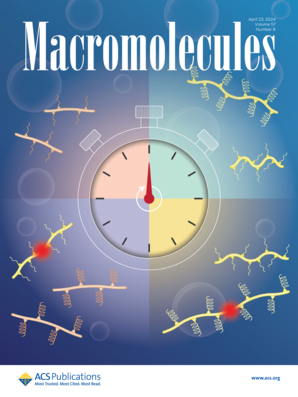Accessing Poly(DA-ran-Dπ) Ternary Copolymers via Direct C–H Arylation for Ultrahigh Photocatalytic Hydrogen Production
IF 5.1
1区 化学
Q1 POLYMER SCIENCE
引用次数: 0
Abstract
π-Conjugated polymers (CPs) bearing alternating electron donor–acceptor (D–A) blocks have been widely exploited as promising photocatalysts for hydrogen production. However, little attention has been paid to the D–A ternary polymer photocatalysts, and the current investigations on such a system are mainly focused on the D−π–A type by inserting a π-bridge between the D and A units. Herein, a new type of ternary polymeric photocatalysts, namely poly(DA-ran-Dπ), were designed and facilely constructed via atom-economical direct C–H arylation polymerization (DArP), in which benzothiophene-5,5-dioxide (DBTSO2), 3,4-ethylenedioxythiophene (EDOT), and phenyl serve as acceptor, donor, and π-spacer, respectively. Our findings reveal that the DBTSO2, EDOT, and phenyl building blocks can exert synergic effects on promoting the hydrophilicity, D–A interactions, and charge separation of the resulting ternary CPs. Compared to the binary polymer EDBz-0, the ternary EDBz-25 exhibits a much superior photocatalytic performance, yielding a hydrogen evolution rate up to 241.5 mmol g–1 h–1 with an unprecedented apparent quantum yield of 28.62% at a 500 nm wavelength without the aid of a Pt cocatalyst. The water-displacing setup reveals that 91 mL of H2 gas can be quickly produced within 2 h by using only 3 mg of EDBz-25 as the photocatalyst. The construction of ternary CPs via DArP, developed in the current work, offers a new opportunity for the design and green synthesis of polymeric semiconductors for renewable energy applications.

通过直接 C-H 芳基化获得聚(DA-ran-Dπ)三元共聚物,用于超高光催化制氢
具有交替电子供体-受体(D-A)嵌段的π-共轭聚合物(CPs)已被广泛用作制氢的光催化剂。然而,人们很少关注 D-A 三元聚合物光催化剂,目前对这种体系的研究主要集中在 D-π-A 型,即在 D 和 A 单元之间插入一个 π 桥。在此,我们设计了一种新型的三元聚合物光催化剂,即聚(DA-ran-Dπ),并通过原子经济的直接 C-H 芳基化聚合(DArP)法方便地构建了这种催化剂,其中苯并噻吩-5,5-二氧化物(DBTSO2)、3,4-亚乙二氧基噻吩(EDOT)和苯基分别作为受体、供体和 π 隔板。我们的研究结果表明,DBTSO2、EDOT 和苯基结构单元可以发挥协同效应,促进所生成的三元 CP 的亲水性、D-A 相互作用和电荷分离。与二元聚合物 EDBz-0 相比,三元 EDBz-25 的光催化性能更为优异,在 500 纳米波长下,无需铂助催化剂的帮助,其氢进化速率可达 241.5 mmol g-1 h-1,表观量子产率达到前所未有的 28.62%。水置换装置显示,只需使用 3 毫克 EDBz-25 作为光催化剂,就能在 2 小时内快速产生 91 毫升的 H2 气体。当前工作中开发的通过 DArP 构建三元 CP 为设计和绿色合成用于可再生能源应用的聚合物半导体提供了新的机遇。
本文章由计算机程序翻译,如有差异,请以英文原文为准。
求助全文
约1分钟内获得全文
求助全文
来源期刊

Macromolecules
工程技术-高分子科学
CiteScore
9.30
自引率
16.40%
发文量
942
审稿时长
2 months
期刊介绍:
Macromolecules publishes original, fundamental, and impactful research on all aspects of polymer science. Topics of interest include synthesis (e.g., controlled polymerizations, polymerization catalysis, post polymerization modification, new monomer structures and polymer architectures, and polymerization mechanisms/kinetics analysis); phase behavior, thermodynamics, dynamic, and ordering/disordering phenomena (e.g., self-assembly, gelation, crystallization, solution/melt/solid-state characteristics); structure and properties (e.g., mechanical and rheological properties, surface/interfacial characteristics, electronic and transport properties); new state of the art characterization (e.g., spectroscopy, scattering, microscopy, rheology), simulation (e.g., Monte Carlo, molecular dynamics, multi-scale/coarse-grained modeling), and theoretical methods. Renewable/sustainable polymers, polymer networks, responsive polymers, electro-, magneto- and opto-active macromolecules, inorganic polymers, charge-transporting polymers (ion-containing, semiconducting, and conducting), nanostructured polymers, and polymer composites are also of interest. Typical papers published in Macromolecules showcase important and innovative concepts, experimental methods/observations, and theoretical/computational approaches that demonstrate a fundamental advance in the understanding of polymers.
 求助内容:
求助内容: 应助结果提醒方式:
应助结果提醒方式:


